The Caribbean
Circumnavigation Page 3 - Our time in the Caribbean - December 2017-May 2018
Saint Lucia - Marigot Bay:
We spent Christmas in Marigot Bay, reputedly the most beautiful bay in the whole Caribbean. It was strange listening to Christmas Carols on the UK's Classic FM, with Bing Crosby singing about white Christmasses and yet at the same time had tropical downpours alternating with hot sunshine on Christmas day. Many Americans seem to come down to this part of Saint Lucia for Christmas, so Marigot Bay was packed, both in the hurricane hole (the marina is designed to keep a 130ft superyacht safe in 100kt winds) and outside. Here a couple of pictures... with Ngahue IV in the background of one - try to spot her!
When it rains here, it really pours down, and we regularly had to bail out Poutini when she had filled up with too much rain water!
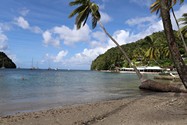 |
 |
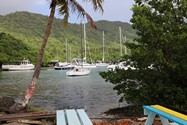 |
 |
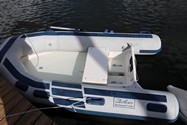 |
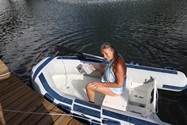 |
On to Martinique:
We left from Marigot Bay marina having checked out with the Customs office there (the customs official who had been absolutely charming the day before was obviously though surprisingly suffering from a bad hair day when we checked out - oh well, we have read lots of horror stories about customs officials, and this wasn't too bad - just a complete surprise after the charming attitude the day before!). The marina staff helpfully explained AFTER we took in our fuel that we should have informed them BEFORE about our intentions to take on fuel in order to get it duty-free. So we paid the full duty on the fuel, making it as expensive as fuel normally is in Belgium. No loss and no gain, and our contribution to the Saint-Lucia Ministry of Finance... We'd used some 420 litres of fuel charging batteries and motoring 85 hours during the ARC - so just under half of our fuel tank. The trip to Martinique was less than comfortable as we were close on a hard wind, bouncing up and down in a moderate to rough sea in between the two islands. Fortunately Le Marin town & its marina is on the south-west side of Martinique and we quickly found our place there before the marina offices closed. A helpful Gustav from the capitainerie took our mooring lines in his dory and quickly had us moored with our stern against the main pontoon, the starboard side of the boat against a small catway and the bow attached to a line attached to a cement block on the seabed. Electricity and water (metered)connections were established and after a quick shower on board we headed for the local bistro for our evening meal. What a difference this French cuisine makes compared to the Saint Lucian international one for visitors.
We spent two days sorting out things for the boat and hired a car for one day to visit the island. The difference with Saint Lucia was pretty obvious and telling: here France and the EU invest heavily; the island also has a larger population, and all is (nearly) like in France; but clearly "à la caraïbe"... Panipwoblem, as is written on many T-shirts... During our stay at the marina, we spotted a sorry-looking HR42 called Hygeia of Halsa. The first picture in the photo block below. After Googling the boat name, we discovered that there was a sordid story of drug smuggling behind the boat; here is a link to what PBO has to write at the time Practical Boat Owner article on the cocaine find
On 31st December we checked out and obtained our clearance papers from Martinique and headed off for Guadeloupe, where the plan had been always to leave the boat 3-4 weeks as we returned to Brussels for me to spend a final 2 weeks with my employer in Brussels.
Our time in Guadeloupe:
We arrived in Guadeloupe on 1st January 2018, and immediately made a grand entrance by wrapping a a fine lobster pot line around our rudder; bending the pushpit when launching the dinghy in a moderately rough sea, demolishing the anchor bow fitting as the same moderately rough sea made our anchor chain jump off said bow-fitting and flatten it plus all the wood around it; and asking the SNSM for a tow to Pointe-à-Pitre because there were lots of other lobster pots around the boat and would have wrapped themselves around our prop if we had tried to motor free.
We had managed to free ourselves from the first lobster pot, but the SNSM needed to cut our anchor and chain (which was recovered several days later only) and guided us through the pots to more open sea. From there we headed for Pointe-à-Pitre under our own steam and ended up - with a certain delay - at the marina where we had booked in for the month. We spent the next couple of days busily sorting out the damage and organising the repairs. So instead of having fun under the sun, we were again contributing to the local economy because some irresponsible fisherman had put out his gear in such a manner that we got entangled into it. This has happened to all my boats and always it has been things like unmarked pots, bits of net discarded in the water, or ropes irresponsibly left just under the water surfeace, etc. that have caused damage to the boat as well as lots of extra worries and expenses. Our love for fishermen has currently sunk to an absolute ebb, and I will heckle anyone of them trying to sell another sob-story in "Brussels" (as the fishing community always does) or against discourse against "Brussels", which the fishing community also excels is (even if realistically, these days, I will have few opportunities to do so, professionally speaking - as my career in BRussels evolves into retirement).
In the picture block a snapshot of HR42E Hygeia currently lying in Le Marin marina and looking very sorry for herself; a shot of what you see at the last moment when you pass an unmarked pot in Guadeloupe; our anchor fitting looking as sorry as Hygeia; the capping rail; how we managed to sail over dry land (according to our Furuno plotter!!! our track is in red/purple and ends with the blue boat moored by the quayside - probably another map drawn by Christopher Columbus and digitised since); and an evening view of our mooring in the marina. There are even pelicans diving into the water behind the boat!
 |
 |
 |
 |
 |
 |
Our temporary return to Brussels:
All along, for administrative reasons, my employer had asked me to return to the office for two weeks in January 2018. I chose the 2nd and 3rd weeks in January to do this, as they were the most "useful" weeks for my President to have me around again. So we found ourselves 2 comfortable seats on the Air Caraïbes flight from Pointe-à-Pitre to Paris (Orly) and exchanged 28°C for 8°C weather. Suffice it to say that the transition was stark, also because the supposedly good service I was expecting from Air Caraïbes was in fact pretty miserable for us. Furthermore, I spent two weeks snuffling and nursing a running nose; never quite knowing whether I was suffering from a severe cold or mini flu. In addition to sorting out the administrative side of my retirement, our letter-box had been full of bills and other cheerful post that needed our immediate attention, and various suppliers of gear for the boat jumped to it as we ordered and collected essential stuff for the boat during the two working weeks that we were in Brussels.
We also attended the new Hallberg-Rassy Connection (Connectie) club in Rotterdam in January 2018 (having been sorely disappointed in the UK HROA's choice to confirm a new Commodore at their AGM in January 2018. Oh well, their choice (we do live in a democracy, but honestly I could no longer be a member of such and Association with this person at their head: their loss if they don't want the old founding members any more!). In Rotterdam we discovered a new group of honest and enthusiastic Hallberg-Rassy lovers with whom to share our Rassonian experiences. In addition to family visits, we also attended André Rieu's New Year's concert in Antwerp (with Laura meeting up with her niece who is one of the star soprano's in André Rieu's shows) and after all this fun started thinking about how to transport Mellie Rassy's toys (see picture of our new muffler - no more leaking in the engine room - and all the other wonderful things we had bought for the boat back to Guadeloupe (picture shows just some of the stuff stockpiled in the office/spare bedroom). Easiest of all were of Mapmedia charts, supplied and updated by Sirko Feldbinder at Mare media: they're all on micro-SD chips. If all things could be so small!
 |
 |
 |
20th January and we return to the boat - our time in Guadeloupe:
Having spent the first of my two weeks at work explaining to colleagues that yes, I was back, but only
temporarily, the second week back was spent explaining that no, they shouldn't worry: and yes, they'd soon be definitely rid of my
presence. I've never liked Italian Opera's where death and departure is spread over several scenes; and just when you think: whew,
he (or she) has gone now, the hero, or buxom soprano heroine raises his/her bulk and voice and is off for another tour of singing
adieus! Laura and I had had so many ideas of what we could do during two weeks, when in point of fact both she and I ran around like
super-charged Exocet missiles, going from target to target and making sure we got everything for the boat together. AT home we caught
up and watched the finals of The Apprentice and Strictly come Dancing 2017, that our television had diligently recorded during our
absence. All in all a heavy programme...
Sweet relief therefore when we finally made it back to Paris (Orly), despite out Thalys train being late, at the regional Paris
metro RER dumping us (with our 6 cases) on the quay of Denfert Rocherau in the pouring rain, or that the luggage handling system
in Orly become oversaturated and stopping just as it was our turn to check in our suitcases! A good 9 hours later we were
back in Guadeloupe, in 28°C and on our broken boat that the various men working for Fred Marine had busily started to repair for
us.
Some pictures of some of the repairs and improvements undertaken... Benjamin (he measures a wee 2 meters!), who represents Elvstrom Sails here, made a cover and a leather protection for our carbon pole, which also needed shortening aby about 30cms. Most of the time our boat was hidden from view by a couple of catamarans; one left and finally allowed me to take this side-aspect picture. Our Volvo Penta instrument panel was falling apart after 22 years; we bought a new one and started moving the instruments and the key from the old panel to the new one, only to discover that our old panel had an irregular extra battery light (it's the little square in between two buttons - check it out on the two pictures. This required an additional hole to be made - but finally I got there; looking okay now. Our trip to date - Nieuwpoort to Pointe-à-Pitre - and our anchor windlass that got an extra service, having (apparently) never been looked at in 22 years... Also the running rigging in our mast is back on track thanks to Arjan Boot of Visser Watersport in Bruinisse making up the necessary lengths of new and cheerful-looking dyneema ropes for our outhaul and genoa & staysail halyards. Arjan, who had sailed the ARC on a German boat, has a whole database with the required lines for the hole HR-range in Bruinisse. Well, Visser Watersport is located next to the Dutch HR importer in Bruinisse, and over the years we've found and bought lots of things for our boats from them. Not surprising really when you bear in mind that so many HR-owners are based her. This notwithstanding, ALL Visser staff are always EXTREMELY HELPFUL in finding or ordering things for you!!!
 |
 |
 |
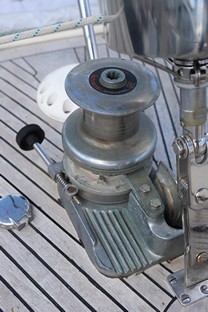 |
 |
 |
January 2018 drew to a close, and so too our time in Guadeloupe. Like in Martinique, we rented a car to go and drive around the island. As true fans of "Death in Paradise" (a BBC crime series set on an imaginary English island called Sainte-Marie in the Caribbean, with as star the bumbling but brilliant Detective Inspector Humphrey xxx), we went to Deshaies where this series was filmed. We saw the church and "maison paroissiale" which served as backdrop for the police state-ion, as well as the beaches and beach restaurants where a lot of scenes were filmed (Guadeloupe is mentioned in the credits, and sometimes you see a boat registered in PP, a give-away for Pointe-à-Pitre). We even found a couple a quiet, white sandy beaches on Grande Terre, and now know every road around the airport as we desperately looked for and never found a Mr Bricolage or a gas station when we needed them. Here some pictures of us being tourists... Pointe-à-Pitre's main market place; Laura sitting on a cannon in Fort Louis Delgrès; the interior of the church next to Sainte Marie's police station (Death in Paradise).
 |
 |
 |
Visiting Antigua - February 2018:
We motored around the south-east part of Guadeloupe and sailed in a brisk north-easterly from La Desiderade on to Antigua, where our destination was English Harbour. We were due to arrive there at 2 a.m. - in the middle of the night, so we decided to sail all around the island, arriving at English Harbour again the next morning - in daylight - at 10 a.m. We were offered a stern-to mooring at the historic quay of Nelson's Dockyard. This is a most pittoresque place, and obviously part of the tourist circuit as every day several groups of tourists walk through the Dockyard and take pictures of all the megayachts, and point at our more moderate sailing boat!!! The wind blew us against the quayside during our first night, causing our Watt & Sea bracket to be bent out of shape (much muttered strong language when this was discovered the next morning). The local Marine Power Services company straightened that out; they also looked at our generator that had again developed an air-lock and was overheating (see notes on technical page). Partly this was due to a burned impeller, and partly due to some other misfortune linked notably to a long cooling circuit. The generator barked hard and loudly at the engineer, who struggled to get a stranglehold on the situation - which eventually he did. We visited Saint Johns, the island's capital, taking bus number 17 from the marina/dockyard. We had it all to ourselves going to St John's at midday; but we were bundled into a Toyota 17-seater in the evening and were thoroughly shaken all the way back to English Harbour! I'm sure that Toyota forgot to install and springs and shock-absorbers when they put together this vehicle. St Johns was also home to 3 cruise-ships the day we were there, including one mega-ship with not two or three, but four (!!!!) bowthrusters. Most of the tourists seemed to hang around the duty-free shopping area on the harbour front, diamonds and other gemstones being the main attraction it seemed...
At English Harbour we witnessed several arrivals of the Talisker Atlantic rowing challenge: young rowers who on average spent 50-odd days at sea rowing across the Atlantic from La Gomera (Canary Islands) to Antigua (English Harbour) - although the really fast ones did the crossing in 30 days - not much more than us on a sailing boat... see one arrival below.
 |
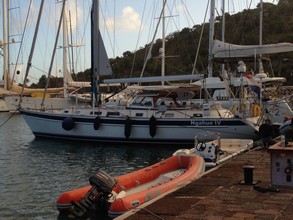 |
 |
From Antigua, our travels continued to Bonaire & Curacao, both still in a formal relationship with The Netherlands, but with a fair amount of sovereignty too... It was during this time that we came to the conclusion that a lot of issues at home and on the boat were "eating into" the pleasure we should be having from our trip around the world. This was due partly to the fact that throughout the final preparations of our boat and our trip we were still working - mainly this was due to the fact that we had been rushed through our final preparations (what to install on the boat - selling the house and buying a small flat - getting things and ourselves ready for a longer period of absence) because the buyer of our HR43 had pulled out of the deal and left us high and dry with the new HR53. Looking after 2 boats for the better part of 2016 and lacking the proceeds from the sale of the HR43 had had lots of negative knock-on effects, even into early 2018. Oh well, our mistake to have had confidence in this person. With things not being 100% fine, it seemed pretty foolish to continue into the Pacific. A sudden issue with our main autopilot made us realise that the wisest move was to return to Europe and put things right both at home and on board before setting off again in the summer of 2019.
The positive side is of our decision is that we can now start implementing all those small ideas and experiences that we have accumulated sailing as far as Curacao to improve our boat and the organisation behind it - on board and at home. We decided to return to Europe with ARC Europe, and to set off next time with more peace of mind via an ARC Plus and a World ARC....
Bonaire and Curacao - February 2018:
It was a nearly 4 day trip sailing across the Caribbean from Antigua to Bonaire. We arrived at Kralendijk just as night fell and started looking for a free mooring buoy. Bonaire protects its diving environment and you are not allowed to anchor between the High Water mark and 60m depth. With only 70m chain on board, anchoring was not an option, so the hunt was on to find a mooring buoy for Ngahue IV. We were out of luck, so headed for the marina, which the next day actually turned out to be nearly half empty. At night of course evrything takes on a different aspect. But two people guided us to a free hammerhead berth on A pontoon, where we moored and went to bed. We spent a couple of days in Bonaire, the first and last of which always to gain entry clearance and departure clearance. In between we toured the south of the island (with its huge salt exporting activity operated by Cargill) and the north. Bonairians complained that there was a lot of rain about and that this winter had been uncharacteristically cold (i.e. less hot for us). During the 4 days at sea we hadn't been bitten by any insects - back on land of course...
The trip from Bonaire to Curacao is a short one - just a couple of hours, which we motored (shame, shame!!! - because we wanted to arrive in Curacao on time, having lost about an hour waiting for the customs officers to turn up when clearing from Bonaire) with the wind right up the boat's stern. Our first night was spent tied up alongside in Boca Seru marina at the entrance of the Spaanse Water. We decided to spend a longer amount of time in Curacao to properly prepare our return to Europe with ARC Europe, and headed off to Willemstad to clear into the Island. The whole process was very pleasant, but because Customs & Immigration are far apart, it took longer than usual.
We decided to stay longer in Curacao because of a period of very strong Easterlies. These strong winds shot down our plans to head off to the south-eastern part of the Windward Islands before heading off to the British Virgin Islands in order to return to Europe with the ARC Europe. We hired a car for a week to drive around the island and to see the various sights it has to offer. On one of our shopping expeditions, we alo discovered that Canon printers are made for specific markets, and that ours, with its 571 series cartridges is fine for Europe; but such cartridges are not available on Curacao, or anywhere in the Caribbean, so we were told. Without becoming unduly nationalistic, one of the pleasures of Curacao with its much larger population than Bonaire, is the presence, for the Dutch expats and others, of 2 Albert Heijn supermarkets. So we happily stocked up on cumin cheese, "dropjes" (liquorice) and other treats from the Netherlands. As we expect this will be our final provisioning spot, we made daily trips to the supermarket to stock up for the return trip to Europe, and to fill our freezer with vacuum-packed steaks. After much tinkering with it, we finally got our "vacuum-packer" to work. It turned out we were being too gentle with the machine and not pressing the lid home hard enough. Ergo, the green light didn't come on and the vacuum-cum-sealing processes didn't start. Once you know...
Some comments on the following images - Ngahue IV in English Harbour, Antigua; about to leave - Moored in Harbour Village Marina in Kralendijk - Just a simple picture showing the 50 shades of blue in Kralendijk harbour; usually the place was crowded out with one or two cruise ships - but then, suddenly, the cruise ships were gone and you had an unobstructed view of Klein Bonaire, a flat island just before the coast of Kralendijk. Two further pictures of Ngahue IV in Curacao's Boca Seru Marina (which confusingly appeared in two different places in our pilot books; so one turned out to be seriously WRONG!!! Most unacceptable; in fact, Ngahue IV is not on the second picture, as we only stayed on this long pontoon upon arrival - The Hato Caves near Curacao airport - regular maintenance of our cockpit winches - and provisioning again: where do you leave everything, and more importantly, can you remember where you left everything?
 |
 |
 |
 |
 |
 |
 |
 |
 |
From Curacao to the BVI (Tortola) - March 2018:
It was about 4 days to get from Antigua to Bonaire. From Curacao to Tortola took us just under a week, mainly because we were sailing against the wind! Furthermore, after a day out at sea, we wanted to charge our batteries and make some hot water. For the first time, our Volvo-Penta played up and set off all sorts of heat alarms after running for 20 minutes. Scratch one Volvo-Penta, with a quick visit to the engine room to see what was happening. Smelly black smoke, mainly. We guessed (wrongly) that the impeller had failed and decided to let the engine cool down. Meanwhile, we put on the generator, which also went on strike some 15 minutes later with odours of smelly burned rubber... We phoned Belgium for technical assistance, and managed to get our Volvo Penta back on line, but felt sufficiently "un-confident" about her to switch her on again... Furthermore, we had discovered that there was a lot of water leaking from the exhaust. Later on, it transpired that all of this looked worse than it actually was. But once we arrived in Tortola, we had a proficient engineer look at the Volvo and the generator. In both cases, the cooling systems were the culprit. New impellers were installed, and in the case of our Volvo-Penta, even a whole new seawater pump and a new muffler in the engine room. The whole exhaust system was cleaned out and old coal deposits removed. Result: a cleanly working main engine, and a reasonably well-working Westerbeke generator (someone actually did refer to out generator brand as Westerbreak, because apparently in the charter business they do have a tendency to break down a lot, much like my experience with the Fisher-Panda generator on our previous boat. We contemplated replacing the Westerbeke by a modern Whispergen unit, as we did on our previous boat. But the engineer who worked on our Westerbeke convinced us that with a new waterpump and a new exhaust elbow (the old one was much eaten up), the Westerbeke was actually in very good shape. We'll give it a try until Europe and then re-evaluate the situation, as we can't really set out on our circumnavigation for a second time with the constant threat of our generator not working...
What we did find on this trip was that by being very careful with energy consumption, we could more or less hang on in there for the remainder of the trip with just our solar panels and our water generator. As the plan is to double our solar panels (from 2 to 4 Solbian SP125s), we should be totally energy self-sufficient with no need for generators and double alternators on the main engine. We need the generator for the 220 Volts it generates for the watermaker; and even though we can go for a long time without filling up our water tank, we will have everything nicely doubled up... To add to our woes, our freezer compressor decided it was time to go on strike, so once we got to Tortola, the contents of the freezer could be ditched as well - a pity! We'll get that fixed in Nanny Cay marina, the place where the ARC Europe departs from in May 2018. That's also where our Furuno autopilot and our Iridium phone need to be given a check-over, as both have been playing up. It seems that when you live aboard, there's always something breaking down...
Just to complete this page 3 pictures taken around Road Harbour, Tortola's capital city... It shows the destruction left by hurricane IRMA; visible 6 months later, with for instance one of the hi-speed ferries (look carefully at the middle picture - work was just commencing to lift the vessel) still thrown on the shore and half encrusted in the ferry terminal building. Not pictured here, but seen: two catamarans that must have flipped and been blown on to shore in one of the town's marinas...
 |
 |
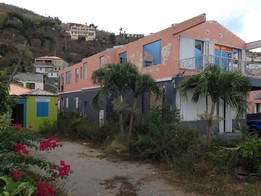 |